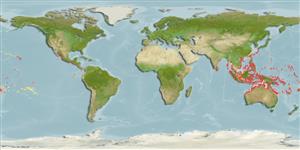Teleostei (teleosts) >
Ovalentaria/misc (Various families in series Ovalentaria) >
Pseudochromidae (Dottybacks) > Pseudochrominae
Etymology: Pseudochromis: Greek, pseudes = false + Greek, chromis = a fish, perhaps a perch (Ref. 45335).
More on author: Bleeker.
Environment: milieu / climate zone / depth range / distribution range
Ecology
Marine; reef-associated; depth range 0 - 30 m (Ref. 37816), usually 0 - 20 m (Ref. 27115). Tropical; 30°N - 24°S
Western Pacific: Peninsular Malaysia to Hong Kong and the Ryukyu Islands, south to Western Australia, and east to Vanuatu and the Gilbert Islands. Replaced by an undescribed species at Fiji and Tonga and Pseudochromis coccinicauda in the Indian Ocean (Ref. 37816).
Size / Weight / Age
Maturity: Lm ? range ? - ? cm
Max length : 6.2 cm TL male/unsexed; (Ref. 90102)
A common but secretive species (Ref. 9710, 48635) found in holes and crevices of exposed outer reef flats and reef margins. Occurs in pairs and feeds on small crabs, isopods, and copepods (Ref. 1602). Usually most abundant in high current or surge areas. Frequently enters the aquarium fish trade and has been bred in captivity (Ref. 37748). Sometimes solitary (Ref 90102).
Life cycle and mating behavior
Maturity | Reproduction | Spawning | Eggs | Fecundity | Larvae
Bi-directional sex change has been confirmed for this species (Ref. 103751).
Myers, R.F., 1991. Micronesian reef fishes. Second Ed. Coral Graphics, Barrigada, Guam. 298 p. (Ref. 1602)
IUCN Red List Status (Ref. 130435)
Threat to humans
Harmless
Human uses
Aquarium: commercial
More information
ReferencesAquacultureAquaculture profileStrainsGeneticsElectrophoresesHeritabilityDiseasesProcessingNutrientsMass conversion
Tools
Special reports
Download XML
Internet sources
Estimates based on models
Preferred temperature (Ref.
123201): 25.1 - 29, mean 27.9 °C (based on 648 cells).
Phylogenetic diversity index (Ref.
82804): PD
50 = 0.5000 [Uniqueness, from 0.5 = low to 2.0 = high].
Bayesian length-weight: a=0.00490 (0.00187 - 0.01281), b=3.11 (2.88 - 3.34), in cm total length, based on LWR estimates for this (Sub)family-body shape (Ref.
93245).
Trophic level (Ref.
69278): 3.3 ±0.44 se; based on food items.
Fishing Vulnerability (Ref.
59153): Low vulnerability (10 of 100).
Nutrients (Ref.
124155): Calcium = 200 [100, 344] mg/100g; Iron = 0.952 [0.548, 1.633] mg/100g; Protein = 18.3 [17.1, 19.3] %; Omega3 = 0.111 [0.061, 0.202] g/100g; Selenium = 26 [11, 58] μg/100g; VitaminA = 142 [43, 447] μg/100g; Zinc = 2.39 [1.54, 3.48] mg/100g (wet weight);
